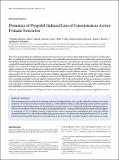| dc.contributor.author | Ishizawa, Y. | |
| dc.contributor.author | Ahmed, O. J. | |
| dc.contributor.author | Patel, S. R. | |
| dc.contributor.author | Gale, J. T. | |
| dc.contributor.author | Sierra-Mercado, D. | |
| dc.contributor.author | Eskandar, E. N. | |
| dc.contributor.author | Brown, Emery Neal | |
| dc.date.accessioned | 2017-02-23T16:21:57Z | |
| dc.date.available | 2017-02-23T16:21:57Z | |
| dc.date.issued | 2016-07 | |
| dc.date.submitted | 2016-05 | |
| dc.identifier.issn | 0270-6474 | |
| dc.identifier.issn | 1529-2401 | |
| dc.identifier.uri | http://hdl.handle.net/1721.1/107119 | |
| dc.description.abstract | The precise neural mechanisms underlying transitions between consciousness and anesthetic-induced unconsciousness remain unclear. Here, we studied intracortical neuronal dynamics leading to propofol-induced unconsciousness by recording single-neuron activity and local field potentials directly in the functionally interconnecting somatosensory (S1) and frontal ventral premotor (PMv) network during a gradual behavioral transition from full alertness to loss of consciousness (LOC) and on through a deeper anesthetic level. Macaque monkeys were trained for a behavioral task designed to determine the trial-by-trial alertness and neuronal response to tactile and auditory stimulation. We show that disruption of coherent beta oscillations between S1 and PMv preceded, but did not coincide with, the LOC. LOC appeared to correspond to pronounced but brief gamma-/high-beta-band oscillations (lasting ∼3 min) in PMv, followed by a gamma peak in S1. We also demonstrate that the slow oscillations appeared after LOC in S1 and then in PMv after a delay, together suggesting that neuronal dynamics are very different across S1 versus PMv during LOC. Finally, neurons in both S1 and PMv transition from responding to bimodal (tactile and auditory) stimulation before LOC to only tactile modality during unconsciousness, consistent with an inhibition of multisensory integration in this network. Our results show that propofol-induced LOC is accompanied by spatiotemporally distinct oscillatory neuronal dynamics across the somatosensory and premotor network and suggest that a transitional state from wakefulness to unconsciousness is not a continuous process, but rather a series of discrete neural changes. | en_US |
| dc.description.sponsorship | Foundation for Anesthesia Education and Research (Grant 5T32GM007592) | en_US |
| dc.description.sponsorship | Harvard Medical School. Eleanor and Miles Shore 50th Anniversary Fellowship Program for Scholars in Medicine | en_US |
| dc.language.iso | en_US | |
| dc.publisher | Society for Neuroscience | en_US |
| dc.relation.isversionof | http://dx.doi.org/10.1523/jneurosci.4577-15.2016 | en_US |
| dc.rights | Creative Commons Attribution 4.0 International License | en_US |
| dc.rights.uri | http://creativecommons.org/licenses/by/4.0/ | en_US |
| dc.source | Society for Neuroscience | en_US |
| dc.title | Dynamics of Propofol-Induced Loss of Consciousness Across Primate Neocortex | en_US |
| dc.type | Article | en_US |
| dc.identifier.citation | Ishizawa, Y. et al. “Dynamics of Propofol-Induced Loss of Consciousness Across Primate Neocortex.” Journal of Neuroscience 36.29 (2016): 7718–7726. | en_US |
| dc.contributor.department | Massachusetts Institute of Technology. Institute for Medical Engineering & Science | en_US |
| dc.contributor.department | Massachusetts Institute of Technology. Department of Brain and Cognitive Sciences | en_US |
| dc.contributor.mitauthor | Brown, Emery Neal | |
| dc.relation.journal | Journal of Neuroscience | en_US |
| dc.eprint.version | Final published version | en_US |
| dc.type.uri | http://purl.org/eprint/type/JournalArticle | en_US |
| eprint.status | http://purl.org/eprint/status/PeerReviewed | en_US |
| dspace.orderedauthors | Ishizawa, Y.; Ahmed, O. J.; Patel, S. R.; Gale, J. T.; Sierra-Mercado, D.; Brown, E. N.; Eskandar, E. N. | en_US |
| dspace.embargo.terms | N | en_US |
| dc.identifier.orcid | https://orcid.org/0000-0003-2668-7819 | |
| mit.license | PUBLISHER_CC | en_US |
